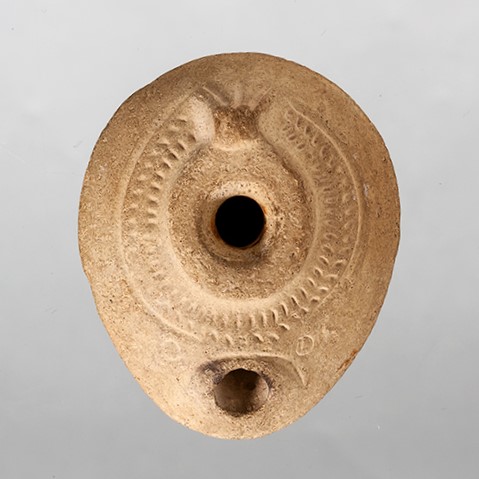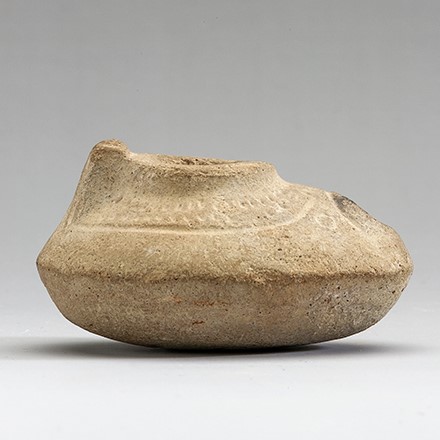Acquisition number: 1990.05
Intact and in fairly good condition. There are traces of burning about the spout. The lamp is mould-made of a hard-fired pale yellow-grey clay. The spout is small and the air-hole high. On the shoulder is a wreath of short incised strokes with a line below. An incised line curves over the spout with two small circles above - so that it looks like a face. The underside is smooth and rounded; on the underside is an incised diamond below a line, each corner marked by impressed circles.
There is a vestigial handle at the back with three vertical grooves on its outer face.
Title: Terracotta lamp - 1990.05
Acquisition number: 1990.05
Author or editor: J.R. Green
Culture or period: Roman Imperial
Date: c. 5th-6th century AD.
Material: Clay - Terracotta
Object type: Lamps - Terracotta
Dimensions: 80mm (l) × 44mm (h)
Origin city: Eastern Mediterranean
Display case or on loan: 11
Keywords: Roman, Imperial, Lamp, Eastern Mediterranean, Roman Asia
1990.05
Terracotta lamp
Gift of Mrs Myra Graneek of Deakin, ACT, in memory of her husband Jack, Classical scholar and University Librarian (1961 – 1972). Max. ht ca 4.4cm; max. length 8cm.
Intact and in fairly good condition. There are traces of burning about the spout. The lamp is mould-made of a hard-fired pale yellow-grey clay. The spout is small and the air-hole high. On the shoulder is a wreath of short incised strokes with a line below. An incised line curves over the spout with two small circles above - so that it looks like a face. The underside is smooth and rounded; on the underside is an incised diamond below a line, each corner marked by impressed circles.
There is a vestigial handle at the back with three vertical grooves on its outer face.
Perhaps of the fifth or sixth century AD and from the Eastern Mediterranean. There are ways in which it is reminiscent of the third-fourth century Egyptian frog-lamps (cf. D.M. Bailey, A Catalogue of the Lamps in the British Museum iii, Roman Provincial Lamps (London 1988) pll. 47-48) but it is not related to them. Rather closer, if much larger, is Bailey, A Catalogue of the Lamps in the British Museum iii, 272 no. Q 2249, pl. 54, particularly in its evocation of a mouse-face; closer still is his Q 2250, pl. 54. They are dated to the sixth and seventh centuries.

